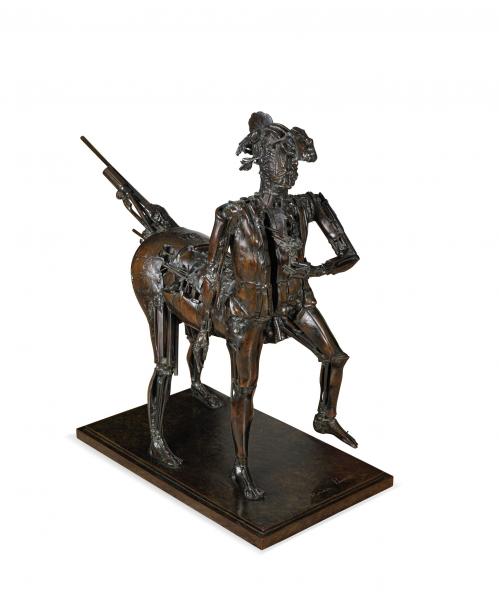Le Centaure, Hommage à Pablo Picasso, 1983-1987
Bronze, Bocquel cast, numbered 7/8, signed on the base left and right and dedicated "Pour Marina Picasso" . 101 x 105 x 48.5 cm.
101 x 48.50 cm
Provenance :
Atelier César
Marina Ruiz-Picasso Collection
Private collection
FROM ONE SON OF THE MEDITERRANEAN TO ANOTHER
Picasso reigns unchallenged in Caesar's pantheon of tutelary figures.
Giacometti and Brancusi had impressed the sculptor with the conviction of their formal conceptions, but Pablo was the genius of matter, intuitively at ease in contact with any material, any malleable substance available. César would have liked to resemble him, even physically, he would assert. He envied Picasso's incredible virile power, both in his artistic creation and in his relationships with women, an inimitable animal magnetism. Picasso is not human, he's a myth. This is why César seized on the image of the Centaur, combining animal strength with human intelligence, to represent the Master.
Shortly after the artist's death, the curator of the Musée Picasso in Antibes launched a major initiative involving a number of contemporary artists, with the aim of celebrating Picasso's legacy through the creation of works in the form of a tribute. However, funds were hard to come by, and it was not until 1983, under Jack Lang's ministry, that the project was relaunched.
César was one of the sculptors chosen, and a public commission was awarded to him. From the outset, César had in fact been working on a number of projects, with the Centaur rapidly emerging as the ideal embodiment of the superman. A small preparatory sketch, around 70 cm high, was soon ready, but when it came to casting the work in preparation for a monumental sculpture... all hell broke loose: "At first, I made a sketch 0.73 cm high, but when I had to change scale at the foundry to make a statue 5 m high, problems arose. The brushes that served as the little Centaur's tail became brooms on the larger scale, and had to be replaced by a shovel, a rake, etc. Then it was the chest that didn't fit anymore, then the leg that seemed too short...".
The following year, César completed a second preparatory stage, about one and a half meters high, before the work was cast by Régis Bocquel in 1985. The five tons of bronze were temporarily installed on the forecourt of the Grand Palais for the inauguration of the FIAC in October 1985, before being moved to the grounds of the Fondation Cartier in Jouy-en-Jossas. The Hommage à Picasso was finally and definitively assigned to the Carrefour de la Croix-Rouge, in the sixth arrondissement of Paris, dominating the Place Michel Debré with its almost five-metre high, rare equestrian statue of the 20th century, that "first" non-equestrian century "of humanity".
Here, César depicts himself as a Centaur wearing a visor mask bearing the effigy of Picasso; the dove of peace, dear to the master, welcomed in the palm of his hand like an infinitely precious heirloom, powerful and fragile at the same time.
From the man's torso, from the horse's entrails, spring a multitude of heterogeneous, menacing elements, while the croup appears unnaturally smooth and polished, terminated in the shape of a tail by inflexibly erect elements that perpetuate this aggressive rigidity.
Eminently phallic, this sculpture suggests that the creative impulse embodied by Picasso's figure is the fecundity of life itself, through the illustration of this outrageously sexual hybrid. As a sort of avowed testament to the sculptor, the Centaur is of particular importance in his work. One of the versions of this model was chosen to seal his tomb in the Montparnasse cemetery.
César on his Centaur: "The work had to be without artifice, but with graceful, supple, light curves. My Centaur was intended to be abstract yet lively, harmonious yet sober, heavy-stepping yet silent, serene yet enigmatic, magical yet realistic. The shapes had to be clear, airy and refined. If I have to synthesize certain forms, I must not betray the animal's characteristics: it must be majestic, powerful, with a constant pose and great presence. The different parts of the body, with their spiraling lines, are neither symmetrical nor regular: they present discontinuous planes that articulate into a whole, exuding great energy. I've always been scrupulous in transcribing anatomy. That's what makes a great sculptor. My sculpture respects the proportions of the Athenian sculptor Polyclète." "Le Centaure is the successful but painful outcome of a long process that involved a great deal of hesitation and soul-searching. Through this monument, I also wanted to convey my emotions and feelings, my doubts, my certainties and also my solitude as I reached the autumn of my life. How many times I had to take the "right distance" to escape from myself, lose sight of myself and come back with a new vision; in all, it took me three years to make and unmake all the parts of the Centaur.
Through this sculpture, I sought to achieve perfection, a kind of immortality. It's my fetish work, and I keep a bronze model by my bed as a faithful companion who shares the most intimate moments of his life."

